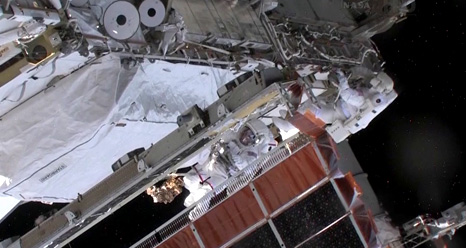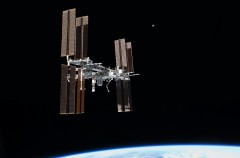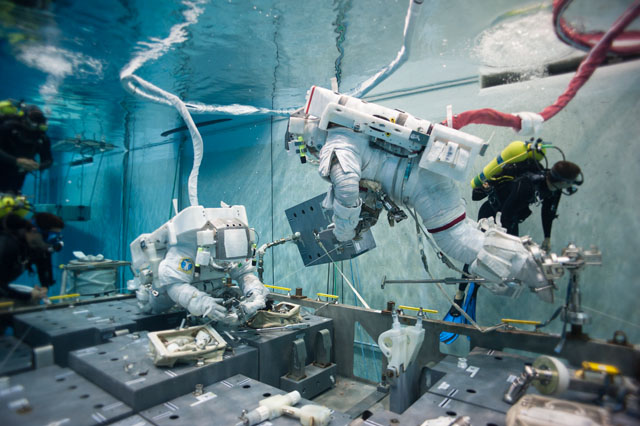
In what may go down in the record books as one of the shortest intervals between authorizing a spacewalk and executing it to perfection, Expedition 35 astronauts Chris Cassidy and Tom Marshburn ventured outside the International Space Station earlier today (Saturday) to identify the source of a puzzling ammonia leak from the outboard P-6 truss segment. The two men—who previously performed a pair of EVAs together during the STS-127 mission in July 2009—spent more than five hours exposed to vacuum. Although they found only a few tiny flakes of leaking ammonia, it was decided to remove, replace, and test a suspect Pump Flow Control Subassembly (PFCS), which will yield additional clues for investigators as they search for the root cause of the problem in the coming days and weeks.
As described by AmericaSpace’s Emily Carney, the leak was visually observed on Thursday in the form of ammonia “snow” emanating from the critical 2B power channel of the massive P-6 truss. This 17,000-pound segment of the station’s football-field-sized structural backbone supports a pair of huge solar array wings, together with integrated energy storage and thermal control subsystems. It carries a pair of PFCS units as part of its Photovoltaic Thermal Control System, and these are responsible for pumping and controlling the flow of ammonia coolant. In turn, this enables the Photovoltaic Radiator to dissipate excess heat into space and properly regulate operating temperatures.

The P-6 segment—which sits at the furthest-port side of the expansive truss—was launched into orbit aboard STS-97 in November 2000, with 52 pounds of ammonia coolant, but since the end of 2006 it exhibited a steady leak of around 1.5 pounds per year. Efforts to circumvent the problem were taken during STS-134 in May 2011, when spacewalkers Drew Feustel and Mike Fincke topped up its ammonia supply, with the expectation that it should not need further attention until about 2015. However, since last summer the leak accelerated to an alarming 5.2 pounds per year, posing the very real threat that the 2B channel—which carries significant electrical loads across the entire ISS—might have been forced to shut itself down before the end of the year. As a result, in November, Expedition 33 astronauts Suni Williams and Aki Hoshide performed a contingency EVA to isolate the 2B loop and use the Trailing Thermal Control Radiator for cooling.
When the latest leak was detected, at around 10:30 a.m. CDT (4:30 p.m. UTC) Thursday, it was unclear as to whether it originated from the same location, but early engineering analyses suggested that its rate alone—5 pounds per day—could have triggered a total shutdown of the 2B loop within 48 hours. The suspect PFCS was shut down, because if it was allowed to deplete its remaining ammonia it would begin to “cavitate,” or take in air, which would cause irreparable damage. Although NASA stressed that the six-man Expedition 35 crew—commanded by Canada’s Chris Hadfield—was in no danger, it was clear that the need for immediate attention was acute.
Cassidy has the most recent EVA training, having arrived at the orbital outpost in late March, and his prior experience with Marshburn made them the logical pairing to perform the task. Former U.S. Navy SEAL Cassidy—described as “the nicest iron man you’ll ever meet” by Hadfield on Twitter—served as EV1, with red stripes around the legs of his suit for identification. Meanwhile, civilian physician Marshburn, touchingly labeled by Hadfield as a “friend for life,” was EV2 and wore a pure white suit.

Back on Earth, at the Johnson Space Center in Houston, Texas, NASA astronaut Terry Virts and European Space Agency astronaut Samantha Cristoforetti—both assigned to the upcoming Expedition 42/43 mission—participated in underwater rehearsals of the work to be conducted. Meanwhile, in Mission Control, serving at the Capcom’s desk for the November EVA and also for today’s excursion by Cassidy and Marshburn, was STS-134 veteran Mike Fincke. He provided an indispensable source of expertise and understanding of the difficulties the spacewalkers faced.
After almost three hours of pre-breathing on masks and a protocol of In-Suit Light Exercise, Cassidy and Marshburn departed the Quest airlock at 7:44 a.m. CDT (1:44 p.m. UTC) and immediately set about the laborious task of translating to the P-6 worksite. Upon reaching the furthest-port tip of the space station, they noticed that the entire system appeared clean, with no trace of leaking ammonia. Slight discoloration, which the spacewalkers likened to a coffee stain, had to be photographed during a daylight orbital pass, when the flash on their camera refused to work.

Despite the apparent lack of an obvious source for the leak, it was prudently decided to remove and replace the 260-pound PFCS from the 2B channel. Cassidy and Marshburn moved rapidly to complete the task, about 2.5 hours into the spacewalk, by closing the Fluid Quick Disconnect Coupling ammonia valves between the PFCS and the truss itself. Only a few specks of frozen ammonia were evident as they drove the bolts into place. “I can’t give you any data,” Cassidy reported at one stage, “other than it looks nominal.”
After exchanging the old PFCS for a replacement, the new unit’s quick disconnects were opened and 20 pounds of ammonia were used to charge the system. This will aid ground-based investigators in their effort to hunt down the root cause of the leak, but it is expected to require several weeks of troubleshooting to determine if the work of today’s EVA has resolved the problem. The “used” PFCS was attached to the long spacer element of P-6. At 11:20 a.m. CDT (5:20 p.m. UTC), ground teams prepared to bring the system back to its normal operating conditions, with no evidence of leaks. Whilst the astronauts monitored the testing of the replacement pump, they were granted the priceless opportunity for free time on an EVA. “Twenty-three minutes to wait,” came the call from Mission Control at one stage. “Sit back and enjoy the view.”
As is customary in such cases—and as was also done by Williams and Hoshide at the end of their EVA last November—the astronauts completed an hour-long “bake-out” protocol to ensure that no ammonia remained on their suits and eliminated the risk of this highly toxic substance entering the pressurized environment of the ISS. Before re-entering the station, Cassidy also paid a poignant tribute to long-time NBL lead diver Marq Gibbs, who died unexpectedly last week at the age of 43. This tribute was echoed by Hadfield, who held up a photograph of Gibbs to the camera inside the Quest airlock. The EVA officially ended at 1:14 p.m. CDT (7:14 p.m. UTC), after five hours and 30 minutes.
Despite much speculation that the EVA would inevitably delay Monday night’s return of Hadfield, Marshburn, and Russian cosmonaut Roman Romanenko to Earth—perhaps by as much as ten days—it seems that Expedition 35 will stick to its original schedule. “Commander Chris Hadfield will ceremonially hand command of the station over to Expedition 36 Commander Pavel Vinogradov on Sunday,” NASA reported on its website. The three men will undock their Soyuz TMA-07M spacecraft from the ISS at 6:08 p.m. CDT Monday (12:08 a.m. UTC Tuesday) and are expected to touch down in Kazakhstan about three hours later, concluding a mission of 146 days in orbit.
Want to keep up-to-date with all things space? Be sure to “Like” AmericaSpace on Facebook and follow us on Twitter:@AmericaSpace




This type of problem is typical of the nagging type stuff we’re going to have to deal with no matter where we go in space.
The value of the ISS goes beyond the science being done, plus being a testing ground for new technologies. It is showing us how durable the guesses we have already been making on technologies really are.
In addition to this leak issue (which had occurred previously), things like the urine processor not working as planned show that it’s best to test out all of our exploration hardware before we have to depend on them far from Earth.
To me, having a place in LEO for testing purposes is one of the most valuable reasons for keeping the ISS.
It’s also important to remember than P-6 is one of the oldest segments of the ISS. It has been in orbit for 13 years.
Ben Harrison’s comments on the ISS serving as a test bed are correct. We must be as sure as possible that the systems work and have a long shelf life. Even then, the unexpected inevitably happens. More importantly, the human health factor is even more critical. No doubt, an advanced propulsion system to reduce travel time will make long distance space travel more conducive in addressing the frailties of human beings and made-made hardware operations.
I also believe that if we ultimately want to safeguard human physiology in deep space as best as possible, a combination of some kind of artificial gravity with faster propulsion systems will be needed.
I am a long time friend of Marq Gibbs, the long-time NBL lead diver that Chris Cassidy spoke of that passed away suddenly at such a young age. I am so proud of the work Marq did helping to secure our place as the worlds top space pioneering nation. I can’t thank Chris and the others that took a moment to honor Marq and the contributions he made to the space program. His wife and daughter would be very grateful.